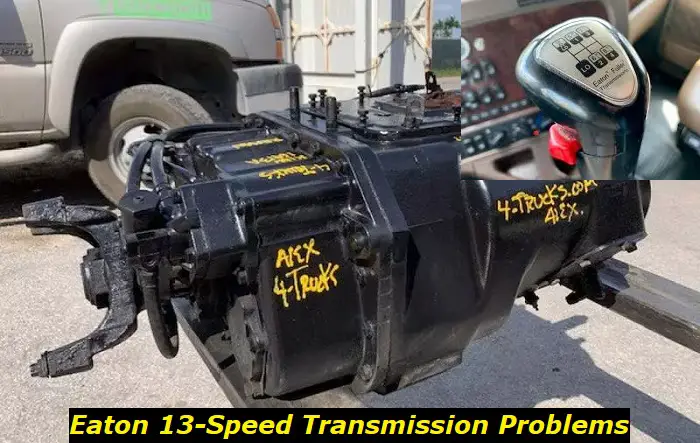Eaton 13-Speed Transmission Problems Explained. Reasons and Fixes
The Eaton 13-Speed Transmission series provides manual or automatic transmission solutions for all types of trucks from Peterbilt to Ford, and from Kenworth to Freightliner trucks. The Eaton 13-speed transmission uses an innovative design with a simple main shaft that is not connected to the auxiliary. The design eliminates drag and inertia that usually affect the auxiliary gear systems.
But like all mechanical parts of a vehicle, the Eaton 13-speed transmission is prone to operational issues. This article intends to provide an in-depth explanation of the Eaton 13-speed manual transmission problems, what causes these problems, and how to fix them when they occur.

What is the Eaton 13-Speed Transmission?
This is a transmission system with 13 forward gears and two reverse gears which with a 5-speed front and a 3-speed auxiliary system incorporated in the system. The transmission system provides a low-shift effort while guaranteeing versatility in all its applications. It is a system suited for performance-minded operators in the fields of bulk hauling, tankers, and general freight haulers.
Apart from the LO and HI ratio gears, the auxiliary section is equipped with an overdrive splitter gear which is applied in both the LO and the HI ratios. The transmission also has a pre-select range shift that synchronizes the range shift when the shift lever moves through the neutral position.
The Eaton 13-speed transmission comes with a shifting pattern decal that indicates the proper shifting pattern of the gears. The pattern is used as follows:
- In the 5-speed front section, the first position is used as the base or starting gear.
- The other four are split between the LO and the HI ratios
- Use the overdrive split gear in the HI range only.
- Once the first gear is used, the operator uses the Roadranger repeat (H) shifting pattern to engage the other gears.
- To select HI or LO range, use the Range Knob or Range Lever which you use once for each of the upshift or downshift sequences.
- In the HI range ratio, the splitter control button is used to split the gear ratios (gears 5, 6, 7, and 8) to get an extra overdrive gear for each. This splitting gives an extra four gears resulting in an eight-speed HI ratio progressive gears.
- When shifting from downshift to upshift, the splitter button and the lever are both moved. However, the low inertia main shaft is synchronized to activate a fast and easy shift
- The auxiliary section has helical gears which provide a quiet operation and increased durability.
Common Eaton 13-speed Transmission Problems
The Eaton 13-speed transmission, despite its reputation, has some common issues that affect it from time to time. These problems include:
Vibrations
Transmission vibrations are common in the Eaton 13-speed (as in all other transmission systems). In most cases, vibrations will be discerned by the driver though other vibrations may occur without his knowledge. Although not all vibrations are related to the transmission, vibrations in the drivetrain will bring the following transmission issues:
- Bearings with faulty rollers or balls within the transmission line will generate unusual noise.
- Worn or cracked gear wears and shocks or mismatched gear sets will cause noise and other transmission issues.
- Gear rattling when shifted to idle position
- Noise coming from the gears and gear console as they shift
- The contact area and fitting service of bearings become fretted
- Loose synchronizer pins
- The shaft spine is worn or broken
- Misaligned or imbalanced driveline
- Broken engine mounts that misalign the driveline
- Worn-out universal joints
Gear slip-outs and Gear jump-outs
When engaging the gears, the clutch movement may fail to engage with the main shaft gear which drives the engine flywheel. This may happen due to misalignment of the gear with the clutch teeth or due to the clutch mating teeth not being in line with the main shaft teeth. Moreover, the gear slip-out may also be a result of:
- Maladjusted shift control linkage causes a partial engagement between the mating gears resulting in a jump-out
- Excessive gear clashes- when there is a heavy or excessive gear clashes due to poor mating, the clutch teeth are shortened resulting in a slip-out
- Worn bushes- worn bushes and loose connections reduce the mating position resulting in a slip-out.
- Transmission mountings being misaligned with the engine flywheel will also lead to a slip-out.
- A slip-out or a jump-out of the gears results in transmission issues
- Swinging of shift levers due to uneven terrain causes the gears to jump out and fail to connect smoothly with the drivetrain
- Worn-out engine mounts- cause a relative movement between the engine and the transmission connection. This may force the gear to jump out when engaged.
Faulty Auxiliary Section
The auxiliary section may have a jump-out when engaging with the splitter set. This occurs when torque is not properly broken during the shifting process causing the clutch gears not to complete the shift but engage only partially. When the torque is reapplied as the gears rotate, the clutch gears slip off or jump out from the splitter set. This damages the clutch gear teeth or the mating gear teeth, thus damaging the auxiliary section.
- This slip out of the auxiliary gears causes a serious transmission issue. Eventually, the clutch gears become tapered, fretted, or worn to make them ineffective. This may completely cripple the transmission.
- These slip-outs cause clutch defects in the long run which affect the entire transmission
- The misalignment of the auxiliary section and the continued slip-outs and jump-outs cause a lot of vibrations to the driveline and the transmission as the mating teeth clash in and out.
Hard Shifting
Shifting gears should be normally a relatively easy and smooth action. Though some gears may require a little bit more effort than others depending on lever position or the vehicle loading and terrain, the shifting should not be too hard or rough.
Sometimes, shifting gears in the Eaton 13-speed may become too hard and rough. If this becomes routine, then, there must be an issue with the transmission. Hard shifting usually arises from linkage problems between the various transmission components (splines, gears, drivelines, flywheels, bearings, and others). These linkage problems may emanate from-
- Bent shift yoke or twisted main shaft which causes clutch gears to bind on the main shaft and prevent proper shifting
- A cracked housing, swollen or sprung yoke bar, or an over-stretched lockscrew can cause the yoke bar to bind in its housing resulting in a hard shift.
Other causes of hard shifting may include:
- Worn out connections
- Worn out bushes
- Lack of proper lubrication
- Maladjusted link rods and bearings
- Worn out bindings
- Any form of obstruction that may restrict the normal movement of parts
Excess Heat
The normal transmission process produces heat due to the friction between moving parts. Under normal circumstances, the transmission operating temperature is around 400C (1000F).
This heat is fritted away by the oil flowing through the transmission case. If heat dissipation is not effective ((when the operating temperature reaches 1200C (2500F), overheating will occur.
- Overheating in the transmission system can be caused by
- Poor or improper lubrication as a result of too much or too little oil, wrong type of lubricant
- High horsepower release due to long overdrive operation
- Airflow restriction in the transmission box due to some blockages
- Consistent operation of the vehicle at very low gear/speed
- Long freewheeling down a hill with a depressed clutch
An overheated transmission does not operate properly and the gears do not engage as envisaged.
Common Fixes To Eaton 13-speed Transmission Issues
When the Eaton 13-speed transmission exhibits problems as highlighted above, the following can be done to rectify the problems.
1. Install transmission oil coolers to assist in heat dissipation as well as increase the lubrication process. This would prevent or rectify overheating and any other issues that arise due to lack of lubrication. The coolers will assist in dissipating the extra heat generated especially when the transmission engages overdrive
- It is recommended that engines above 350hp with overdrive transmissions be fitted with oil coolers
- Those engines above 399 hp, a GCW above 90,000 lbs, should be fitted with an oil cooler to assist in the lubrication.
2. Carry out routine inspections on the transmission system to identify signs of aging, misfits, broken, or overused parts. Once spotted, these parts should be repaired immediately to avoid affecting the transmission system. Also, check and confirm the lubrication and maintenance records and routines.
3. Use an expert to disassemble the transmission system to check for the sources of the problems exhibited by the transmission system or parts. This would pinpoint the exact cause of failure and enable the repair or replacement of specific failed or faulty parts.
4. Ensure the driver uses the correct techniques of engaging and disengaging the transmission gears. This would avoid failures associated with improper use.
5. Check for worn mounts and bushes. Have all the defective ones replaced to avoid the common issues of misalignment between the moving parts in the transmission system.

Add comment